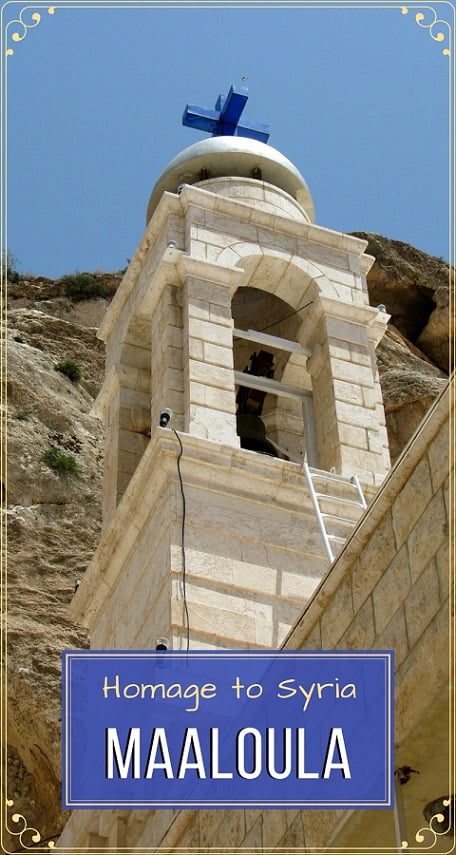
If you need a freelance travel writer or you would like to see your country, city, flight, etc., presented on the blog, drop me an email.
Find our more on Freelance Travel Writer page.
*I was fortunate enough to travel to Syria and see the country in 2008, three years before the war broke out. This homage to Syria is a reminder, the story about the country with immense cultural heritage, posted here with the wholehearted wish for peace to be restored and cities rebuilt.
Welcome to Maaloula Syria!
One of the places in Syria you will be amazed by is situated only 56 kilometers from Damascus, among the rocks of the Anti-Lebanon Mountains that separate the country and Lebanon. High up in the mountains lies a small settlement by the name of Maaloula where people still speak the Syrian dialect also known as the Western Aramaic language.

This Christian village was always well known worldwide for this dialect was used, believe it or not, by Jesus, and some books of the Old Testament were written in it.
The whole village was tucked into mountain rocks and gradually spread down. When we approached the settlement coming from the valley, there was a beautiful view of the whole Maaloula.
Church bell towers were peaking among buildings and up there, at the highest rock, there was the large Statue of Jesus watching over the whole Christian village. Streets curved between buildings and you could see that the small town was live and bustling, people were chatting and shopping for groceries.

There were private houses, scattered over surrounding rocks, just as they were floating in the air.
Maaloula was also famous for housing two monasteries – dedicated to Saint Thecla, and Saint Sergius and Bacchus. The village was tightly linked to the history of the pagan Saint Thecla converted by Saint Paul.

The Greek Orthodox convent is erected at the place where she was said to have found permanent refuge. According to the legend, the mountain miraculously opened, creating the narrow gorge in the upper part of the village that allowed the girl to escape from her persecutors.
Local nuns smiled at us while we were trying to climb the stairs towards the church, which was decorated with beautiful Christian frescoes. And while standing in front of the church I looked up towards the extraordinary sight – a part of the monastery looked as if it was emerging from the rock.

The other monastery seemed even more authentic. It was built in stone with a small courtyard and authentic frescoes inside. Sergius and Bacchus were Roman officials who converted to Christianity in the late 3rd century AD. After you have come such a long way and reached Maaloula Syria and the monastery, the monks would have respectively invited you to come in and taste their wine.

There was a small Lebanese restaurant on the outskirts of the village of Maaloula Syria with traditional specialties where we took our lunch break. There were also children on the street who were reciting a couple of sentences in Western Aramaic! They were extremely likable even though you don’t understand a word.
There was another special town not far from Maaloula Syria which has been constantly inhabited for five millennia, just like Damascus was. The town of Hama flourished in the 2nd millennium BC when it was the capital of the Aramaic dynasty of Syro-Hittite culture.

Subsequently, it was conquered by the Assyrians, the Persians, and then the Macedonians. A relative decline occurred during Roman and Byzantine times, while the city’s entry into the Islamic world in 638 AD marked a new period of prosperity.
One of the most interesting and best-preserved monuments of the time was without doubt the Al Nuri Mosque on the right bank of the Orontes River built in 1170.

This river was very important to Hama since it housed a special town attraction tourists from around the world came to see. Those were the giant wooden water wheels also known as the norias, used until not so long ago to draw and distribute water from Orontes to the city. They were still used for several months a year at the time I visited but with the sole purpose of maintaining the traditional image of the city since Orontes waters subsided over time so much that the wheels could not even reach its surface.
They say that it was quite a sight witnessing norias spinning because they produced a specific sound, creaking and squeaking, that was hard to forget.

There were still 16 of them in 2008, half the number originally built, and almost all of them dated back to the Middle Ages.
When it comes to the town itself, besides the monuments that gave a special atmosphere to the place, there was a smell of stale water in the air that was hard to miss. It made it a bit hard to breathe considering the 30 degrees Celsius in May.

There were a lot of people on the streets, like in any other Syrian town I visited that year, but the traffic seemed chaotic with everyone seemingly going the way they chose, along with honking to everybody and everything. The Syrians passing by didn’t seem to notice it somehow.
We passed by boys sitting on a few boxes on the nearby stairs. They smiled as though they were the happiest in the world. People were selling all kinds of goods lined up on the floor. Another shoe-shining boy was at the corner, and covered women were looking at us with their beautiful eyes like we just came from a different planet…
What a confusing and interesting atmosphere!
Next: PALMYRA TEMPLE
The full Homage to Syria SERIES

If you need a freelance travel writer or you would like to see your country, city, flight, etc., presented on the blog, drop me an email.
Find our more on Freelance Travel Writer page.
I am looking forward to working with you.




28 responses
I have solo traveled 33 countries and haven’t been to Syria yet. You were lucky, thanks for sharing your experience and adding to my intrigue. Keep exploring.
I’ve traveled solo a lot and this was one of those journeys. Glad you like the series, thanks!
Such an unusual place to visit. The frescoes are so beautiful with their bright colors.
This small town was really special, hope it endures through this war.
What an interesting place. Maalula looks like it was a wonderful place to explore. I hope they find peace soon.
Yes, it was, truly intriguing place. You are somewhere in the Middle East in Syria, surrounded by mountains, and yet there was the Orthodox Christian monastery, the Greek one! 🙂
It was so interesting to read your account of Syria and to see your beautiful pictures, it makes me think again just how sad the conflict is and how I wish it will be resolved soon. It is such a shame.
So true. Thank you!
That monestary is gorgeous! The norias are pretty incredible too! It is amazing that the Aramaic dialect has been preserved there.
Such an amazing fact, isn’t it! Thank you. 🙂
I don’t think most Americans associate Christianity with Syria. Many of these Middle Eastern countries have ties to Christianity. It is a shame people are not more aware. Thanks for sharing your experience. I would be interested in knowing what this area is like today.
There are a lot Christians in the region, there always were. A lot of heritage places are in Syria and surrounding countries. Hope they will all be preserved for future generations.
I have enjoyed reading these posts about Syria. This is what I love to read about a county. Great series!
Thank you, so glad! 🙂
This is fascinating. I would love to be able to visit Syria one day, although how much would be left, and how open the people would be after so much conflict would be interesting to see.
Let’s just hope things will settle down soon and we’ll all be going to visit one day. 🙂
Thank you for reposting this article after so long time and it’s a good reminder that the people there are humans; women, men, children and not just an anonymus group of people who are living in the wrong country at the wrong time.. I hope the people in Syria will be able to have a normal life somewhen in not too far future
Me too, thank you!
Love this post! It made me know a lot more about Syria. I’ve never thought I’d be interested in going there soon, but you made me change my mind
Glad if I’ve made you think of the country differently, as a place of great history! Thanks! 🙂
What an interesting place! I love all of the historical and religious architectural details, and the people seem nice, too. It is so sad that some of the places have been completely destroyed by the ravages of violence.
Hope most of those places would still be there! If you like history, this would be the perfect little town for you to explore. 🙂
Again another very interesting post to read. So great to be able to read nice and positive things about this place, that we only mostly read from the news. This is such and amazing country with lot of history and great things to see. I wish someday I would be able to visit too.
Thank you, Paula! That was actually the idea, to remember the country in regards to something more than just war and politics.
Thanks for sharing this post, it’s really sad to see what selfish interests of a few individuals can do to the people, culture, and the nation.
Such a shame…
Not a destination everyone travels to. Glad you covered this place before the war. Does these monuments still exist?
Not sure. I’ve heard there were heavy fighting in town, it was besieged for number of time during this six-year war, so I guess they might have easily been damaged. Fingers crossed, they are still there!